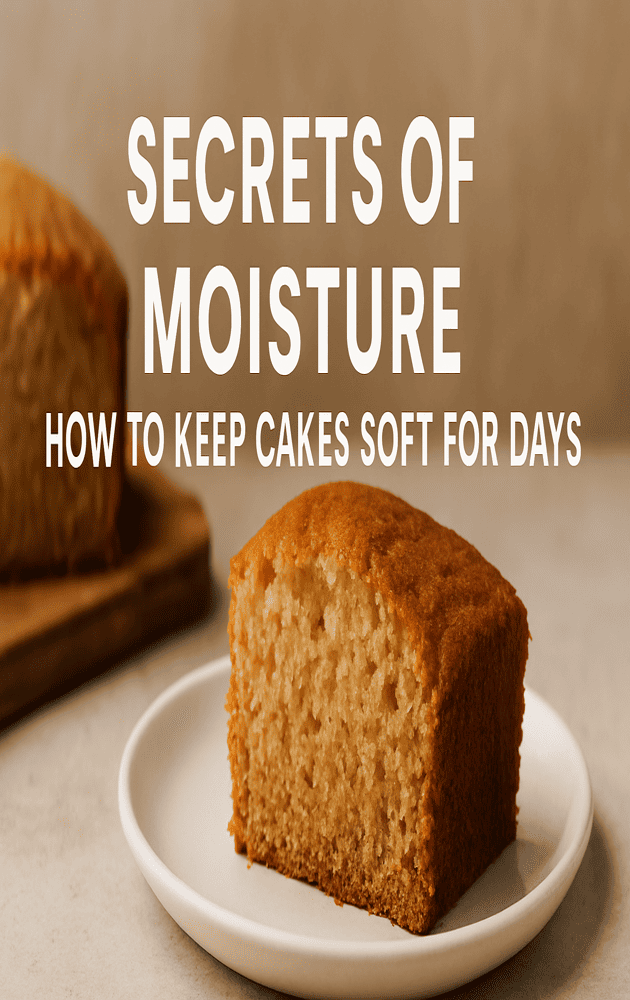You bake a cake, your home fills with that comforting aroma, you slice into it while it’s still warm — and it’s perfect: moist, soft, and flavorful. But the next day? The magic seems to disappear. What was once fluffy becomes dry. Sound familiar?
Keeping a cake moist and tender for more than a day is one of the biggest goals (and struggles) for home bakers, whether you bake for fun or for business. The secret doesn’t lie in one magic trick — it’s in a set of choices and techniques, from the recipe to how you store the cake.
In this article, we’ll explore everything you need to know to make sure your cake stays delicious beyond the first slice. And as always, we’ll connect this with what you’ve already learned in previous articles — especially about fats (article #8), liquids (article #9), oven temperature (article #10), and melt-in-your-mouth texture (article #14).
What is a moist cake, really?
Before anything else, we need to understand what defines a “moist” cake. It doesn’t mean underbaked or soggy. A moist cake has:
- A soft crumb that melts in the mouth
- Light, tender texture that doesn’t crumble dryly
- A fresh feel, even after two or three days
This ideal texture is the result of a balanced ratio of wet and dry ingredients, the right mixing technique, and proper storage.
Let’s dive into the real secrets behind lasting moisture.
1. Use the right ingredients
Ingredient choice is one of the biggest factors when it comes to moisture.
- Moist sugars like brown sugar or demerara retain more moisture than white sugar
- Eggs emulsify and provide structure (see article #5)
- Yogurt, sour cream, buttermilk, or fruit purees add natural moisture
- Honey and corn syrup are hygroscopic — they draw moisture from the air to keep the cake soft
- Melted chocolate, as we discussed in the last article, also adds moist richness
Pro tip: cakes made with vegetable oil instead of butter tend to stay moist longer — even if the flavor is more neutral.
2. Keep ingredient ratios balanced
A dry cake may have too much flour or not enough fat. A wet cake may collapse if there’s too much liquid.
A good starting point for balanced cakes:
- For every 1 cup of flour:
1/2 cup fat + 1 cup sugar + 2 eggs + 1 cup liquid (milk, yogurt, etc.)
These proportions may vary depending on your mix-ins like cocoa powder, nuts, or fruit.
3. Don’t overmix the batter
Overmixing activates gluten, which leads to a chewy texture that loses moisture quickly (as we covered in article #11). Undermixing can leave you with uneven results. The best approach:
- Mix sugars and wet ingredients thoroughly first
- Then gradually add the dry ingredients, gently folding
- Use a spatula or silicone spoon to finish — be kind to your batter!
4. Bake at the right temperature and time
Even the best recipe can turn dry if it’s overbaked. Your cake is done when a toothpick comes out with a few moist crumbs — not completely clean.
Baking tips:
- Bake at 160°C to 170°C (320°F to 340°F) rather than higher
- Don’t open the oven for the first 25 minutes
- Always bake on the center rack for even heat
As you learned in article #10, the oven’s behavior can make or break your cake’s texture.
5. Add moisture-locking toppings
Toppings and glazes act as a barrier to lock in moisture. The best options include:
- Chocolate ganache
- Simple sugar glaze
- Whipped cream
- Fresh fruit with syrup or jam
Avoid very hard icings that can form a crust and dry out the cake underneath.
6. Store your cake properly
Even the moistest cake can dry out if it’s not stored correctly. Here’s how to keep it fresh:
- Let it cool completely before wrapping or covering
- Use an airtight container or wrap tightly in plastic wrap, pressing the wrap directly onto the cake surface
- If using whipped cream toppings, refrigerate
- Simple cakes can be stored at room temperature for up to 2 days if well sealed
- For fruit or cream-filled cakes, refrigerate and bring to room temperature before serving
Another tip: Don’t cut the whole cake at once. Each cut exposes the moist interior to air and speeds up drying.
7. How to rescue a dry cake
Even if your cake is a bit dry, you don’t need to throw it away. Try these fixes:
- Brush with a simple syrup (sugar + water + flavoring)
- Serve with ice cream, whipped cream, or chocolate sauce
- Crumble and reuse in cake jars or layered desserts
Remember: nothing needs to be wasted. A little creativity turns any mistake into a delicious opportunity.
Conclusion
Perfect moisture isn’t a mystery — it’s the result of smart choices and gentle care. From ingredient selection to mixing, baking, and storage, every step matters. When you understand how to control moisture, your cake won’t just shine on day one — it will still bring smiles on day two or three.
In the next article, we’ll build on this theme by exploring “How to Bake a Healthy Cake Without Losing Flavor”. Yes — moisture and softness can absolutely exist in cakes with less sugar and fat.
Stay with us — because a truly soft cake is a lasting joy.
